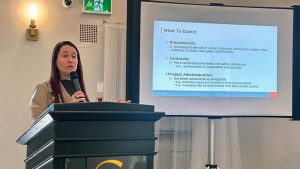The R. v. Greater Sudbury saga is expected to continue into 2025, Annik Forristal, co-group head of ’s National Infrastructure and Construction Group, told attendees gathered for the annual general meeting.
According to the McMillan website, in August, the Ontario Superior Court of Justice dismissed the Crown’s appeal of the Trial Court’s earlier ruling in the matter, confirming Sudbury acted with due diligence, despite the tragic incident that occurred at a construction site. As a result of the dismissal, Sudbury’s acquittal of several charges under the provincial Occupational Health and Safety Act was upheld.
“We’re expecting that the Crown, the ministry, will appeal the Superior Court decision…That will take more time,” Forristal explained.
Forristal was one of the speakers at the AGM, held in Mississauga, Ont. Oct. 17.
“What has changed is the liability and obligations and your other project parties’ understanding of what they need to do and what they have to do on the site,” she said. “They’re going to be relying on you even more because they’re saying, ‘OK, part of how I be duly diligent is making sure that you are qualified, making sure that you are doing your job and how do I prove that I did that.’”
What contactors can expect
She talked about what the contractor level can expect to see going forward in response to these decisions.
“All roads are going to lead back to you as a constructor in terms of the person ultimately responsible for taking in this feedback, providing that documentation, implementing all of that. And of course that comes with time and resource costs,” she added.
In September 2015 the City of Sudbury had contracted with Interpaving to repair a watermain in the downtown core. An Interpaving employee was reversing a grader on the site when a pedestrian was struck and killed.
The case made its way through the lower courts and to the Supreme Court of Canada after various appeals. After two years, the court issued its decision on the case in November 2023.
“The Court of Appeal found that the city was an employer under the Occupational Health and Safety Act not only because they had a worker onsite, their own employees doing the quality checks…they were also an employer by entering into a contract with Interpaving,” Forristal explained.
It was a split decision, with eight justices ruling, meaning the Ontario Court of Appeals decision remains in place.
Since the decision was handed down owners have been including certain requirements in contracts in an effort to show they are doing everything to ensure the contractors they hire are qualified.
One of the things contractors can expect to see in terms of procurement, is an increased likelihood of owners requiring certification and/or other evidence of health and safety qualifications.
“Owners, they’re looking to delegate control, and they need to do that clearly. Part of the test they have to meet is to show they make sure you’re qualified,” said Forristal. “How are they going to do that? By including more stringent prequalification requirements in their tendering processes. So we’re anticipating seeing more often requests or requirements for certification like COR, like ISO.”
For contracts, owners will require more comprehensive health and safety obligations.
“Things like asking for what is your safety plan for the project as part of what you submit with your bid, increased prequalification requirements that could include certifications as owners try to establish that ‘yes, I did do everything I could to make sure that the contractor I hired was properly qualified and I did my due diligence.’”
She said contractors can expect more comprehensive, more detailed health and safety clauses in contracts.
“You might also see representation, so you say, ‘I represent that I do have the requisite experience, qualifications to take on the role of constructor,’” she noted.
In terms of project administration, Forristal said there may be increased obligations. Part of that may be managing health and safety communications from other project parties such as architects and engineers.
“Unfortunately for them the case law is not speaking directly to how this might be applied to them,” Forristal explained. “You might see consultants raising those comments more frequently now themselves, not because they’re trying to do their job, but because they’re trying to make sure they’re being proactive. They have employees at the site and if something were to happen they would want to be able to be prepared and say, ‘no, we did everything we could to make sure our employees had training.’”
Follow the author on X/Twitter @DCN_Angela.





Recent Comments
comments for this post are closed